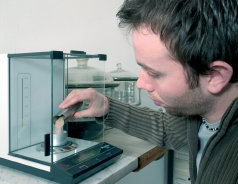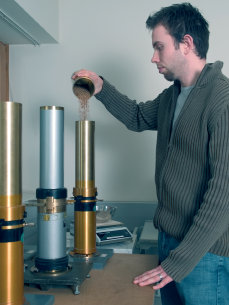Moisture of Cereal Grains
Water content of grain

The moisture of cereal grains is an important economic quality criterion for the assessment of the storing properties of grain and the for fixing the prices at loading places for grain. As a biological good the grain contains absorbed water as well in the corn as at the surface. The content of moisture is determined in different ways depending on the method used. The accurate content of water of the various kinds of grain can be only determined according to a standardized determination procedure, the so called realization procedure. Based on that procedure the content of moisture of grain is defined as the loss of mass which the product is subject to under specified conditions.
The measuring instruments in practical use implement other measuring principles than that of direct drying – because of the long time of the drying process. Therefore, all grain moisture measuring instruments on the market and subject to mandatory verification have to be measured each year according to the realization procedure.
Each stored quality of grain is shred and a prescribed quantity of the sample is dried in a Chopin oven for three hours at a temperature between 130°C and 133°C. The content of moisture of the grain under test can be determined exactly by the relation of the loss of mass by drying and the mass of the wet sample.
Moisture of grain = (loss of mass / mass of wet sample) · 100 %
Verification of grain moisture measuring instruments
Measuring instruments for the determination of grain moisture are subject to mandatory verification in Austria. Acceptable for verification are only instruments type approved by BEV or EEC approved in the frame of the agreement of the European Economic Area (EEA agreement). Verification of grain moisture measuring instruments is carried out by the legal metrology authority. The interval of subsequent verification is two years.
Measurement of the electrical conductivity:
The electrical conductivity increases considerably by increasing content of water of the grain and the measurement of the electrical conductivity can be carried out as measurement of the resistance of the grain sample e.g. by measuring the current at constant voltage according to Ohm´s law or by a bridge circuit.
Measurement of the dielectric constant:
The high dielectric constant of water is a useful measure for the content of water of a grain sample. The capacity of a capacitor like measuring cell is measured with the grain sample under test as dielectric.
Measurement of the absorption of electromagnetic radiation:
In the NIT procedure (near infrared transmission) the absorption of electromagnetic radiation transmitting the unshred sample is determined in the region of the near infrared. The absorption is in relation not only to the content of water but also to a series of other ingredients (protein, e.g.).

The hectolitre mass of cereals
The hectolitre mass of cereals is a further assessment criterion. It is determined by weighing a capacity measure filled in a specified way. Reference value is the value determined by the 20 I national standard instrument of the BEV.
In practice instruments for the determination of ¼ l and 1 l grain are used. They are traceable by tables to the measurement results of the 20 I national standard instrument.
Verification of the hectolitre mass standard
Hectolitre mass standards are subject to mandatory verification in Austria. Acceptable for verification are only instruments type approved by BEV or EEC approved in the frame of the agreement of the European Economic Area (EEA agreement). The verification of hectolitre mass standards is carried out by accredited verification bodies in Austria. The interval for subsequent verification is 2 years.
Content of protein
The content of protein is determined according to the procedure of Kjedahl (reference procedure). All instruments in service operating according to a physical measurement principle are measured by this reference procedure.
The grain sample is decomposed by concentrated sulphuric acid under adding a catalyst (K2SO4 + CuSO4 . 5 H2O) at 420 °C, whereas the nitrogen in the protein of the grain is transformed into ammonic sulphate. By adding sodium hydroxide the nitrogen is set free in the form of ammonia which is by vapour distillation as ammonia hydroxide converted into a neutral weakly buffered solution. This now alkaline solution is titrated by sulphuric acid of exactly known concentration to the change of the indicator. The consumption of the titrating acid can be converted directly into the content of nitrogen in percent and furthermore by an empiric factor depending on the kind of the protein into the content of protein.